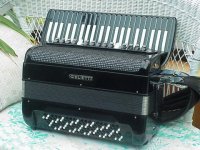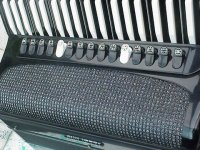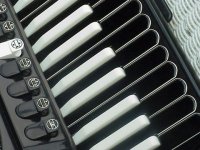snavoyosky
Member
The Bassetti V-6
When I went to a music school to study music composition and music theory, I had to have a major instrument and a minor instrument. I chose piano and clarinet.
I had never studied either instrument before and registered for first year courses in spite of that, and accepted. I had my full year piano requirement almost complete in the first semester. I did this without having a piano at home....using the school's to practice on.
My first recital on piano had me doing two pieces in two months. One of them is at the end of this email. The other was very fast and called Solfeggietto in Cm by C.P.E.Bach
The Bach piece was easy for I had done that entire two-hand melodic line with just my right hand on accordion.
And so years later, 1987 to be exact, I designed a special instrument that resembled an accordion but was actually a different instrument and which I called a Bassetti. The left hand buttons were all single pitch instead of three note chords. This allowed me to be a two-handed musician rather than the right hand melody and left hand accompaniment (omp-pah-pah). I had an exceptional factory in Italy build it for me according to my specifications...and design. (photos of it are attached)....... It's one of a kind.
So in early 1988, I received the Bassetti...and never playing such a left hand system before...I found my college piano music to Chopin's Prelude in E minor Opus 28 No. 4 as it would work my left hand in such a way (wandering harmonies) that made me quickly learn the in's and out's of that new system....and it revealed that my newly designed left hand system was very logical, for one could sight-read with it without much of a problem.......the true test of any instrument.
Here is a recording and the piano music of that piece. I think it's a beautiful romantic composition and sad.
And yes, it's for sale should anyone be interested. BTW, the low notes are at the bottom end when playing, and it's a B system chromatic. Two reed lines are in unison to give a better spark. All quality wood, walnut keyboard, with high quality handmade Baldoni reeds. Zero Sette made it for me. I had them send it to me through Giulietti and Julio applied 'his' name on it.....but it's all mine. There is a sordino.
With the low notes at the bottom, you can see that your fingers will be playing the notes in the same way as they appear on the music. ....just like reading piano music on a piano. That in itself makes things easier. Note that the buttons and the keyboard are color reversal making all white your sharps/flats.
The left side is a double three row B system chromatic. You have yards of latitude with 6 rows and making many easy fingerings. The left side, besides two reeds in unison the entire distance (E upward to Eb above the C above middle C) is also on a wooden foundation plate making for a 'tone chamber' quality sound and projecting.
Most accordions with free bass attached are weak on that side and are drowned out by the right hand side.
Another advantage is that your low reed playing is usually for octaves and fifths while your higher playing will now allow for 4 part playing with ease and better bellows control.
When I went to a music school to study music composition and music theory, I had to have a major instrument and a minor instrument. I chose piano and clarinet.
I had never studied either instrument before and registered for first year courses in spite of that, and accepted. I had my full year piano requirement almost complete in the first semester. I did this without having a piano at home....using the school's to practice on.
My first recital on piano had me doing two pieces in two months. One of them is at the end of this email. The other was very fast and called Solfeggietto in Cm by C.P.E.Bach
The Bach piece was easy for I had done that entire two-hand melodic line with just my right hand on accordion.
And so years later, 1987 to be exact, I designed a special instrument that resembled an accordion but was actually a different instrument and which I called a Bassetti. The left hand buttons were all single pitch instead of three note chords. This allowed me to be a two-handed musician rather than the right hand melody and left hand accompaniment (omp-pah-pah). I had an exceptional factory in Italy build it for me according to my specifications...and design. (photos of it are attached)....... It's one of a kind.
So in early 1988, I received the Bassetti...and never playing such a left hand system before...I found my college piano music to Chopin's Prelude in E minor Opus 28 No. 4 as it would work my left hand in such a way (wandering harmonies) that made me quickly learn the in's and out's of that new system....and it revealed that my newly designed left hand system was very logical, for one could sight-read with it without much of a problem.......the true test of any instrument.
Here is a recording and the piano music of that piece. I think it's a beautiful romantic composition and sad.
And yes, it's for sale should anyone be interested. BTW, the low notes are at the bottom end when playing, and it's a B system chromatic. Two reed lines are in unison to give a better spark. All quality wood, walnut keyboard, with high quality handmade Baldoni reeds. Zero Sette made it for me. I had them send it to me through Giulietti and Julio applied 'his' name on it.....but it's all mine. There is a sordino.
With the low notes at the bottom, you can see that your fingers will be playing the notes in the same way as they appear on the music. ....just like reading piano music on a piano. That in itself makes things easier. Note that the buttons and the keyboard are color reversal making all white your sharps/flats.
The left side is a double three row B system chromatic. You have yards of latitude with 6 rows and making many easy fingerings. The left side, besides two reeds in unison the entire distance (E upward to Eb above the C above middle C) is also on a wooden foundation plate making for a 'tone chamber' quality sound and projecting.
Most accordions with free bass attached are weak on that side and are drowned out by the right hand side.
Another advantage is that your low reed playing is usually for octaves and fifths while your higher playing will now allow for 4 part playing with ease and better bellows control.






